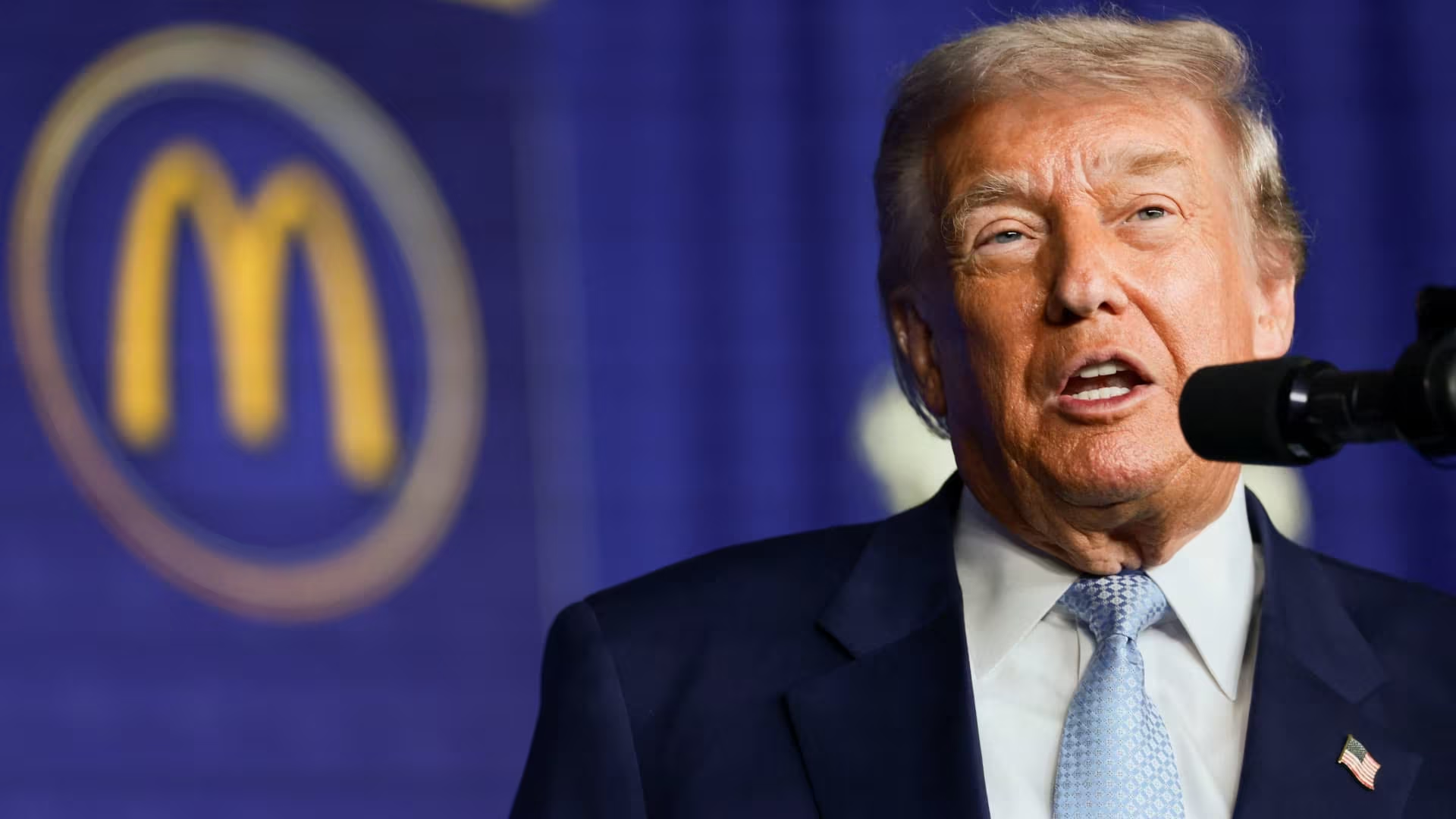Trump’s Claims Ignite Debate Over California’s Landmark Wage Law
On Monday, November 17, 2025, former President Donald Trump used a high-profile industry event to launch a sharp critique of California’s new minimum wage law for the fast-food sector. Speaking at the McDonald’s Impact Summit at the Westin Hotel in Washington, D.C., Trump asserted that the state’s mandated $20 per hour minimum wage is actively “hurting businesses,” leading to job cuts, reduced hours, and significant price increases for consumers.
While Trump’s remarks framed the policy as a clear economic failure orchestrated by California Governor Gavin Newsom, the reality of the law’s impact is far more nuanced. Economic data and industry reports suggest that while businesses are certainly adjusting—often through automation and price hikes—the overall effect on the state’s massive economy and workforce remains complex and subject to intense debate.

The Mechanics of AB 1228: Who is Covered by the $20 Mandate?
California’s Assembly Bill 1228 (AB 1228) is not a blanket minimum wage increase for the entire state. Instead, it is a highly targeted piece of legislation designed specifically for the quick-service restaurant industry. The law, which took effect on April 1, 2024, raised the minimum hourly pay for employees of large fast-food chains to $20.
Key Provisions of the Law:
- Targeted Scope: The law applies only to fast-food chains that have 60 or more locations nationwide. This specifically targets major national and international brands, exempting smaller, independent, and regional chains.
- Wage Floor: Establishes a minimum wage of $20 per hour, significantly higher than the state’s general minimum wage.
- Future Adjustments: The law also created the Fast Food Council, a body tasked with setting future annual wage increases and developing working condition standards for the sector, providing workers with a direct voice in industry regulation.
This targeted approach was intended to address the historically low wages and often precarious working conditions within the high-volume, high-profit fast-food sector, particularly in a state with one of the highest costs of living in the nation.
Industry Response: Price Hikes and Staffing Shifts
Trump’s central claim—that the wage hike is damaging businesses—is supported by anecdotal evidence and specific adjustments reported by several major chains. Companies faced with a sudden and substantial increase in their labor costs have responded primarily in two ways: raising consumer prices and restructuring their workforce.
Business Adjustments Reported Since AB 1228:
- Price Inflation: Multiple major chains, including Chipotle and McDonald’s, confirmed they have raised menu prices in California to offset the higher labor expenses. Some reports indicated price increases ranging from 5% to 15% on certain items.
- Automation Acceleration: Many chains are exploring or implementing greater levels of automation, particularly for tasks like order taking and food preparation, reducing the reliance on human labor.
- Staffing Reductions: Perhaps the most visible impact has been on employment. Several large Pizza Hut franchisees, for instance, announced the elimination of dedicated delivery driver positions, shifting delivery responsibilities to third-party apps like DoorDash and Uber Eats. This move affected hundreds of drivers across the state.
- Reduced Hours: Some smaller franchise owners have reportedly cut employee hours to avoid triggering benefits requirements or simply to manage payroll budgets.
“The $20 minimum wage in California is a disaster. It’s hurting businesses, it’s hurting the workers, and it’s hurting the consumer with higher prices,” Trump stated during his address, positioning the law as a prime example of detrimental government overreach.

The Economic Reality: A Complex Equation
While the immediate negative impacts—job losses in specific roles and consumer price increases—are real, labor economists emphasize that the long-term, net effects of the $20 wage are far more complicated than political rhetoric suggests.
The Trade-Offs in Labor Economics
- Increased Worker Spending Power: The primary goal of the law is to provide a living wage, injecting significant capital into the hands of low-income workers. This increased disposable income often translates into higher consumer spending, which can stimulate local economies and potentially offset some of the business costs.
- Low-Wage Job Churn: The fast-food sector often experiences high turnover. Higher wages can lead to greater employee retention, reducing training costs and improving service quality, which benefits businesses in the long run.
- Inflationary Pressure: The wage increase undeniably contributes to cost-push inflation within the fast-food category. However, economists are still debating whether this localized inflation significantly impacts the broader California economy, which is massive and diverse.
- Automation vs. Efficiency: The push toward automation, while causing short-term job displacement, can also force businesses to operate more efficiently and invest in technology, potentially leading to higher productivity per worker.
Crucially, the law has only been in effect since April 2024. Comprehensive data on employment changes across the entire sector, sales figures, and long-term price stability will take months, if not years, to fully materialize and analyze.
Precedent and Historical Context
California has historically been a testing ground for progressive labor laws. Previous minimum wage increases, while often met with similar warnings of economic collapse, have generally resulted in modest employment effects while substantially improving the financial stability of low-wage workers. The sheer magnitude of the $20 jump, however, makes AB 1228 a unique case study.
Political Context and National Implications
President Trump’s decision to highlight the California wage law at a major corporate summit underscores the national political polarization surrounding labor standards. Minimum wage policy has become a key battleground issue, often dividing along partisan lines.
For Republicans, like Trump, the narrative focuses on the burden placed on businesses, the potential for job losses, and the principle of free-market operation without heavy government intervention. They often cite the specific examples of job cuts and price hikes as proof that such mandates fail.
For Democrats and labor advocates, the focus is on income inequality and ensuring that workers in profitable industries can afford to live in the communities where they work. Governor Newsom has defended the law as necessary to address the cost-of-living crisis.

The California experiment is being closely watched across the country. If the state can demonstrate that the wage increase leads to a net positive for workers without crippling the industry, it could provide a powerful blueprint for other high-cost states considering similar legislation. Conversely, widespread business failures or sustained, high inflation could halt such efforts nationally.
Key Takeaways for the Reader
Understanding the impact of California’s $20 fast-food minimum wage requires looking beyond political soundbites and focusing on verifiable economic data:
- The Law is Targeted: AB 1228 applies only to fast-food chains with 60 or more locations nationally, not all California businesses.
- Immediate Business Response: Companies have reacted predictably by raising prices and, in some cases, cutting specific roles (like delivery drivers) or accelerating automation plans.
- Trump’s Position: The former President characterizes the law as a “disaster” that hurts consumers and businesses, aligning with conservative arguments against mandated wage floors.
- Economic Complexity: The long-term economic impact is still uncertain. While costs rise, increased worker spending power and reduced turnover could provide stabilizing benefits.
- National Significance: California serves as a crucial test case for the viability of high-minimum-wage policies in major U.S. markets.
Conclusion
President Trump’s criticism of the $20 fast-food minimum wage in California accurately reflects the immediate challenges faced by franchise owners and the resulting price increases borne by consumers. However, the full economic picture is still developing. The law represents a significant governmental intervention aimed at correcting wage stagnation in a high-cost environment. Whether this intervention ultimately results in a net benefit for the state’s economy—balancing higher worker welfare against inflationary pressures and automation—will be determined by data collected over the next several years, not by initial political claims.
Original author: Amelia Lucas
Originally published: November 22, 2025
Editorial note: Our team reviewed and enhanced this coverage with AI-assisted tools and human editing to add helpful context while preserving verified facts and quotations from the original source.
We encourage you to consult the publisher above for the complete report and to reach out if you spot inaccuracies or compliance concerns.

